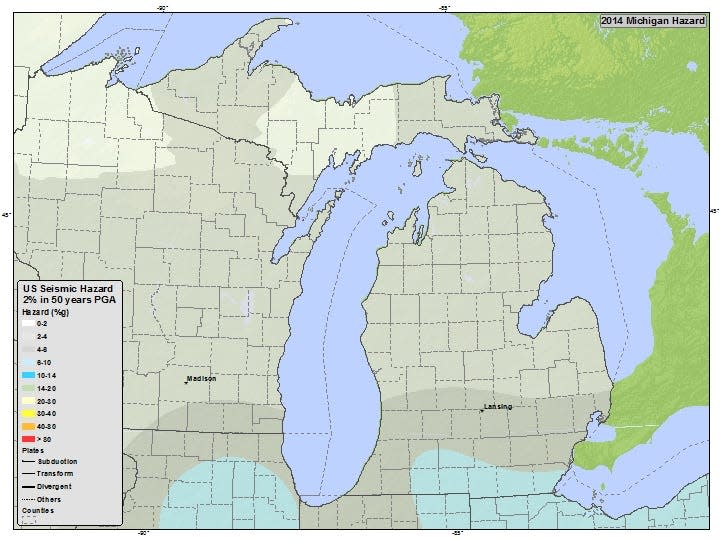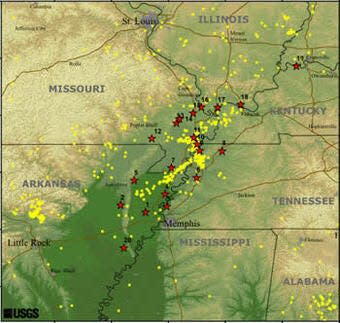It's rare to feel an earthquake in Michigan, but state does have fault lines
Over here in the Midwest, we're much more familiar with tornadoes, floods, freezes and other severe weather incidents. Earthquakes remain an afterthought — but they're not impossible.
According to the U.S. Geological Survey (USGS), earthquakes are caused by a sudden slip on a fault as two tectonic plates grind past each other. Under the Earth's crust, tectonic plates are constantly and slowly moving, but sometimes the edges of two get stuck. As the stress between the two plates builds and builds, eventually the two come undone and whatever pent-up energy is released, sending waves of energy to shake the Earth's crust beneath our feet.
Some states are littered with fault lines where two tectonic plates meet, like California, where the North American plate and the Pacific plate slide past one another closer to the west side of the state. But most of the continental U.S. sits calmly on the North American plate, where faults and natural earthquakes are a much rarer occurrence.
So, with so few faults in the state, why are earthquakes — ever so rarely — felt in Michigan?
Earthquakes in Michigan
In a paper on seismic activity in Michigan published in 1977, geologist D. Michael Bricker listed 34 earthquakes with epicenters in the state — 30 from fault-slippage activity and four man-made from mining operations — that occurred between 1872 to 1967. Since 1994, the USGS has recorded five natural earthquakes with epicenters below Michigan land and one within Michigan borders under Lake Erie.

In Michigan, most fault lines that were potentially visible long ago are now buried deep under sedimentary deposits, so we often don't know they exist until an earthquake happens along them. For example, a fault outside of Kalamazoo was revealed after a 4.2-magnitude earthquake in 2015 — the state's largest since a 4.6-magnitude quake along the same fault in Coldwater in 1947.
But still, how are earthquakes happening in the Midwest, where there are no tectonic plate boundaries to scrape against each other?
There are a number of theories out there, with the simplest explanation being that movement and pressure on the distant plate boundaries is still creating interior plate stress contributing to our earthquakes, but the truth is that scientists still don't know.
"We are not entirely sure why earthquakes happen in Michigan, or elsewhere in the eastern U.S. Most earthquakes occur at the boundaries between tectonic plates, such as the 'Ring of Fire' around the Pacific Ocean plate. Earthquakes within a tectonic plate, like those in the eastern U.S., do not have a clear, obvious cause," said USGS research geophysicist Dr. Thomas Pratt.
More: Small earthquake hits near US-Canada border
Outside of Michigan, felt in Michigan
Even at low magnitudes, earthquakes can be felt in different cities than they originate in, just like Michigan's most recent 3.2-magnitude earthquake in 2020 with an epicenter about 2 miles offshore of William C. Sterling State Park in Lake Erie was felt up through Sterling Heights and as far away as Bowling Green, Ohio.
However, buried under several states to the south-southwest of Michigan lies the New Madrid fault line, extending 120 miles from southeast Missouri into northeastern Arkansas. But in the event of a strong quake, parts of surrounding states as far as Ohio may suffer damages, with states as far as Louisiana, South Carolina, Pennsylvania, Kansas and — you guessed it — Michigan able to feel the shaking.

That's exactly what happened in the 1811 and 1812 earthquakes, when three earthquakes estimated to be between 7.0-8.0 magnitude rocked New Madrid. There was structural damage as far as Cincinnati, and St. Louis, with tremors felt as far as Hartford, Connecticut, Charleston, South Carolina, and New Orleans. The quakes even reversed the flow of the Mississippi River in areas near New Madrid, Missouri.
According to the Jackson County Emergency Preparedness Department in Missouri, scientists now record an average of 20 minor quakes each month and tremors strong enough to be felt at a 2.5-3.0 magnitude at least once a year. So, while the quakes may not be coming from Michigan, the New Madrid seismic zone certainly contributes to the shakes we feel every once in a while.
What to do
While incredibly unlikely, in the event of a strong earthquake in Michigan, the state advises you to stay safe by:
Dropping to your hands and knees to avoid being knocked down by the shaking of an earthquake.
Taking cover under the safety of a sturdy table or desk while being sure to protect your head and neck. If there is no stable shelter nearby, get down near an interior wall or low-lying furniture, careful to steer clear of objects that may fall on you and windows or glass that could shatter. Be prepared to move with your shelter in case the shaking causes it to shift.
Hold on to your shelter or otherwise protect yourself until the shaking stops.
This article originally appeared on Detroit Free Press: Earthquakes rare, but can be felt in Michigan despite few fault lines

